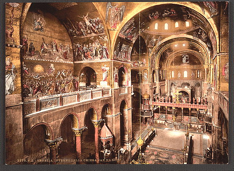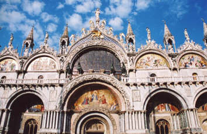I Fagiolini, Florilegium, His Majestys Sackbuts and Cornetts, December 1993, Union Chapel, Islington
Christmas Vespers in Venice (c.1630)
Magnificent ceremonial music by the greatest composers of early Baroque Venice
Performers: 9 singers, 2 violins, 8 early brass, 2 organs, 2 theorbos
Extra requirements: organ and harpsichord
Monteverdi – Vespers psalms
(1610 Vespers, 1640 Selva Morale e spirituale)
Grandi – Plorabo die ac nocte
Gabrieli – Quem vidistis pastores; Magnificat for three choirs (Symphoniae sacrae, 1615)
Plainchant antiphons
“The music… so good, so delectable, so rare, so admirable, so super excellent, that it did even ravish and stupifie all those strangers that never heard the like… I was for the time even rapt up with Saint Paul into the third heaven.â€
Thomas Coryat, 1608
 Magnificent ceremonial music by the greatest composers of early Baroque Venice with Vespers psalms by Monteverdi, from his famous 1610 collection.
Magnificent ceremonial music by the greatest composers of early Baroque Venice with Vespers psalms by Monteverdi, from his famous 1610 collection.
Gabrieli’s glorious 14-part Magnificat, throwing its sacred conversation between three groups of voices and brass instruments.
Virtuosic instrumental works and grand motets including ‘Quem vidistis pastores’, whose gleaming colours and high emotional charge rub off even on the lowly shepherds.
Venice, circa 1630: a city of splendour and luxury, serene in its republican independence; a city of magnificent public events, revelling in a stream of ostentatious display. At its heart, the Piazza San Marco with its gilded basilica in which on forty major feast days a year celebrated some of the most brilliant and lavish rites in Christendom. Enormous processions began the ceremonies: robed clergy, ambassadors, papal nuncios, the Doge and Senate dressed in bright gowns, all moving from the Doge’s Palace to the basilica’s great West door, to be greeted by music of unparalleled majesty, resounding from galleries spaced around the building.
No occasion was more splendid than Christmas Vespers. For such a service the Doge could expect music of a grandeur unique to Venice and provided by composers of the calibre of Giovanni Gabrieli and Claudio Monteverdi, often using multiple ensembles of solo voices and instruments. These were distributed on either side of the area by the altar and pala d’oro (the choir) in the house style of cori spezzati (‘separated choirs’).
“Hollingworth’s marrying of the delicate sounds of theorbos, two baroque violins and organs with the muted brightness of the English Cornett and Sackbut ensemble was a model of clarity. The music of Giovanni Gabrieli, pioneer of the glorious polychoral effects that Monteverdi inherited at St Mark’s, was reserved for the evening’s climax. The performance of his 14-part Magnificat was simply magnificent.†The Guardian
“When the brass joined the processional at the back of the hall, the effect was electrifying… A contemporary observer of such an event spoke of being ‘rapt up with Saint Paul into the third heaven’. By the end of this sumptuous aural feast, we were up there with the apostle.†Evening Standard
- I was thinking that. Also @JolyonMaugham was (which carries a little more weight). https://t.co/pAu9emYdGd
- For my birthday I have done admin, walked dog, and rehearsed Walton with @The24choir https://t.co/jNTU2B3UIw https://t.co/LDhso8U9jS
- It's very reasonably priced and all those benefits.... https://t.co/DFJS8e9Dqw

